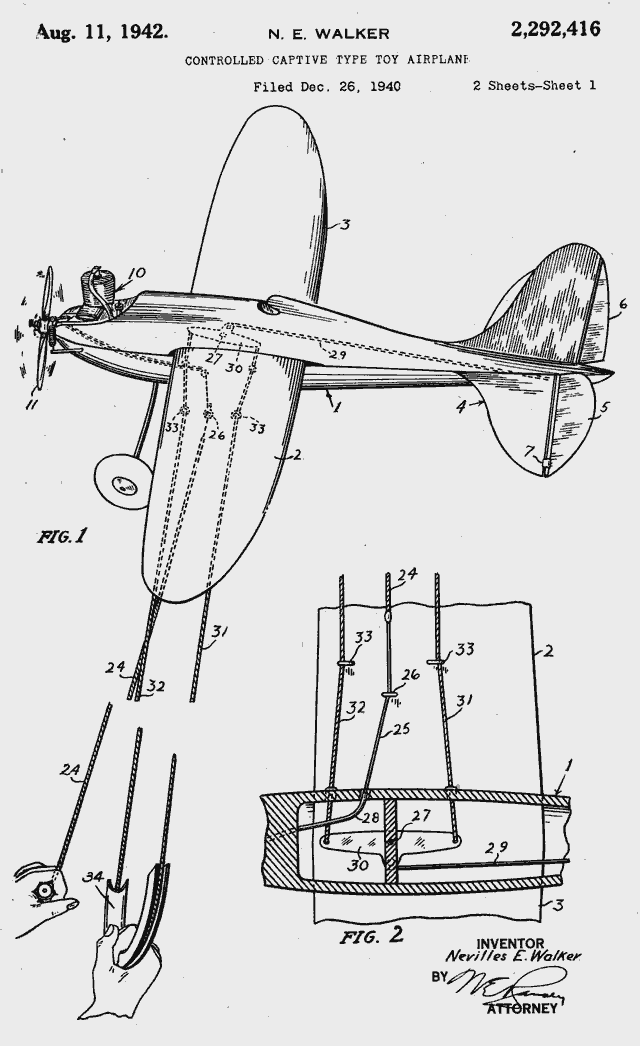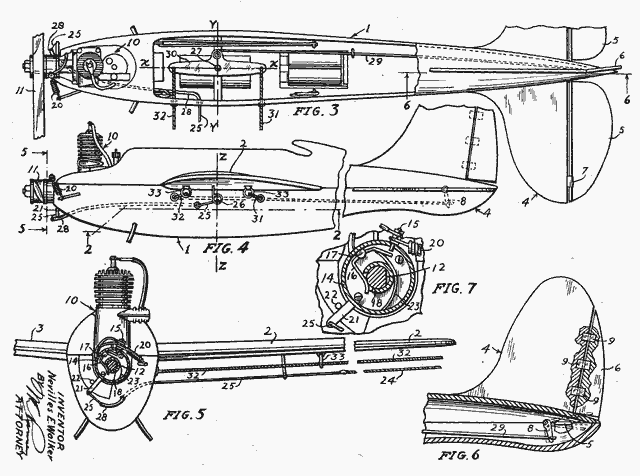
Jim Walker's Patent for U-Control
![]() Hear Jim Walker talking about the
U-Reely in 1941.
Hear Jim Walker talking about the
U-Reely in 1941.
Jim Walker was granted the patent for his system of control line flying in 1942. Jim Walker held the patent for the system he called U-Control for 12 years. After a four year court battle concerning infringements, his patent was "nullified." The decision was not contested because of Jim Walker's failing health, so the patent was lost. This was a devistating blow to Jim Walker. None of us can contest Jim Walker's contributions to model aviation and to the promotion of control line flying as a major sport. We offer the original patent application as a historical document - part of our control line past.
UNITED STATES PATENT OFFICE
2,292,416
CONTROLLED CAPTIVE TYPE TOY AIRPLANE
Nevilles E. Walker, Portland, Oreg.
Application December 26, 1940, Serial No. 371,621
14 Claims. (Cl. 46-78)
Please note: Use of the term "toy airplanes" is due to the lawyers insistence of "legalese" and
certainly not Jim Walker's choice of words.
 |
Fig. 1 is a foreshortened perspective view of a power driven, string controlled toy |
Notice Jim Walker's early attempt at speed control with the third line.
 |
Fig. 3 is a fragmentary plan view of the airplane shown in Fig.1;
|
The following is an exerpt from Jim Walker's patent papers
My invention relates to toy airplanes of the so-called captive type, and it relates more particularly to power propelled captive toy airplanes. Because of the difficulty in recovering power propelled toy airplanes after a flight, and also because the airplane frequently struck buildings, trees, or other objects during the flight, it has heretofore been attempted to limit the flight of the airplane by attaching it to one end of a string, the other end of which is retained in the hand of the operator. This expedient has not been generally successful, however, because it has not been possible to control the airplane by means of a string; its flight has merely been limited to a circular path.
With a captive type airplane flying in a circular path at the end of a string, it is desirable to be able to control the height of the plane for the purpose of flying an airplane in the wind, for avoiding obstacles, as well as for amusement. This may be done by controlling the position of those portions of the tail structure of the airplane commonly called elevators. However, I have found that moving the elevators of a captive airplane to cause it to rise will not by itself produce the desired result because, as the airplane rises, it loses velocity and the centrifugal force which had theretofore held the control strings taut and at some part it diminishes sufficiently to allow these strings to slacken. Said airplane as it climbs describes a circle of smaller diameter, and as the string extends progressively upwards its tautness is diminished. Then if the operator cannot readily control the elevators with slackened strings, the airplane dives and crashes.
To prevent slackening of the control string, it is desirable that the airplane be caused to yaw outwardly whenever the elevators are moved to cause the airplane to rise. Furthermore, this outward yawing is desirable to prevent the airplane making an inward (and downward) dive when it has ascended sufficiently so that it travels in a small circle, the control string then being directed upwardly at a considerable angle.
One of the principal objects of my invention is to provide control strings for a captive type toy airplane whereby the airplane will be caused to yaw outwardly or inwardly as the elevators are moved to cause the airplane to ascend or descend, respectively, and whereby the airplane will be caused to roll to bank it properly for different heights. I achieve said object by providing a pair of strings attached to the ends of a centrally pivoted lever the pivot of which is located substantially at the longitudinal center of mass of the airplane, the lever being operatively connected to the elevators by suitable means. Then, with this lever in its normal position arranged lengthwise of the body of the airplane, when the operator pulls on the rearmost string to move the elevators to cause the airplane to rise, the force exerted by the string will be applied to the airplane somewhat behind its center of mass, and the airplane will thus be caused to yaw outward. On the other hand, when the operator pulls on the forward string ' to move the elevators to cause the airplane to descend, force will be applied to the airplane, forward of its center of mass and it will tend to yaw inward.
To assure proper banking and to secure lateral stability of the airplane, the aforesaid strings are passed along the under side of one wing, passing thru rings attached to the wing and thus maintaining the wing substantially parallel to the strings. Thus, when the airplane is near the ground and the strings are substantially horizontal, it will be banked only to the extent of its dihedral, whereas when the airplane has ascended so that the strings slope upward it will be banked because of the slope of the strings in addition to its dihedral.....
.....I have found that, by following the principles herein expounded, I can build a toy airplane that can be controlled extremely accurately. Furthermore, with reasonable care in its operation, there is little danger of its destruction thru loss of control. For example, I can cause a captive type toy airplane to fly in a vertical loop and then resume its flight, a feat hitherto unperformed as far as I am aware, although it has been attempted many times.
I prefer hand grip or spreader 34 to be U-shaped, and I find it advantageous to hold said grip vertically, as shown in Fig. 1. The reason for this position of the hand grip or spreader will be understood if it be assumed that, with the airplane flying steadily, the hand grip or spreader be held perfectly still, as it strings 31 were tied to a stake somewhat above string 32. Then, when the airplane tends to descend for any reason, the tension of string 31 will be increased thus causing the airplane to tend to ascend. When the airplane climbs the tension of string 32 will be increased thus causing the airplane to descend. In this way, the tendency of the airplane to either climb or descend is opposed, and the stability of the airplane is increased. I find that even a comparatively slight spacing of strings 31 and 32 at the hand grip or spreader 34 increases the stability of the airplane to a worthwhile extent.....
Nevilles E. Walker
| Go back to Workshop index page | Go back to A-J Home page |